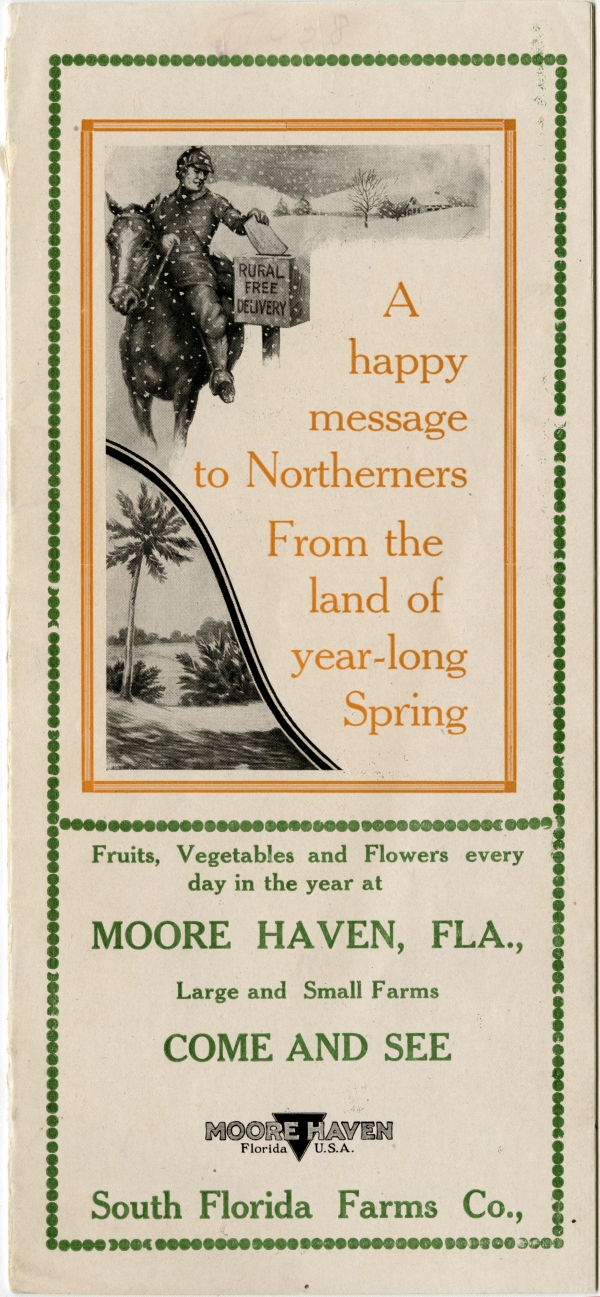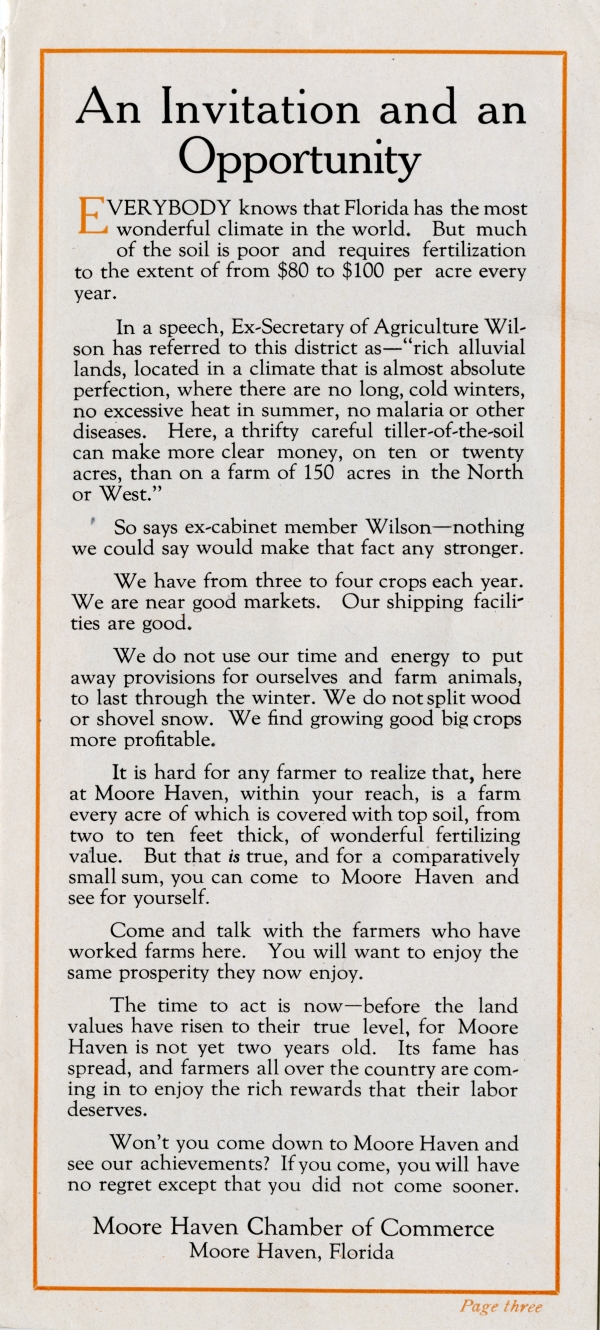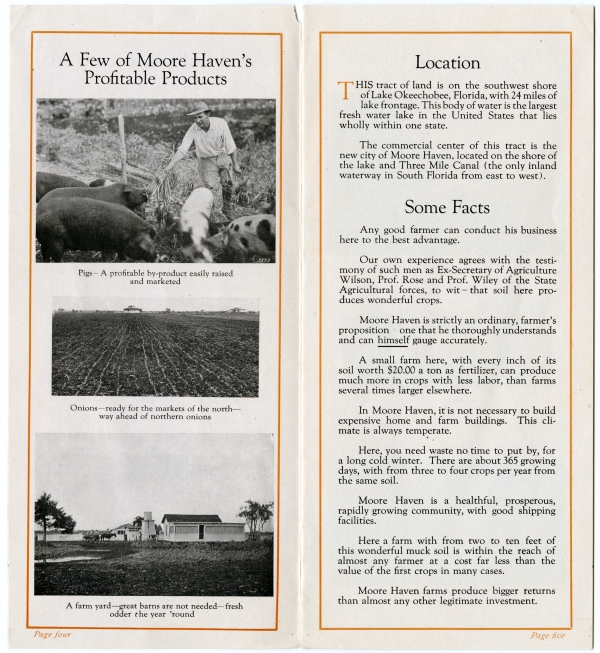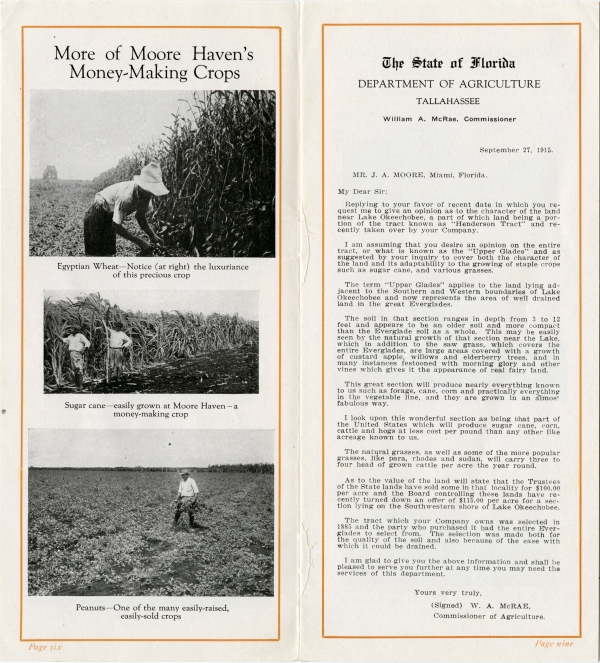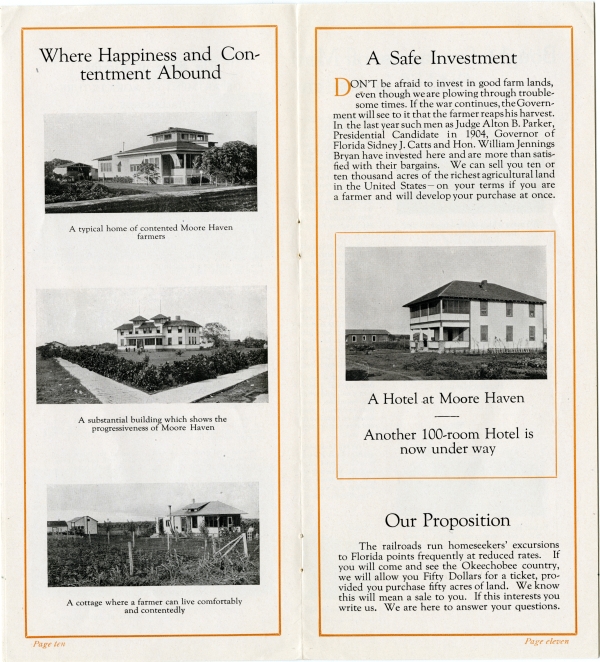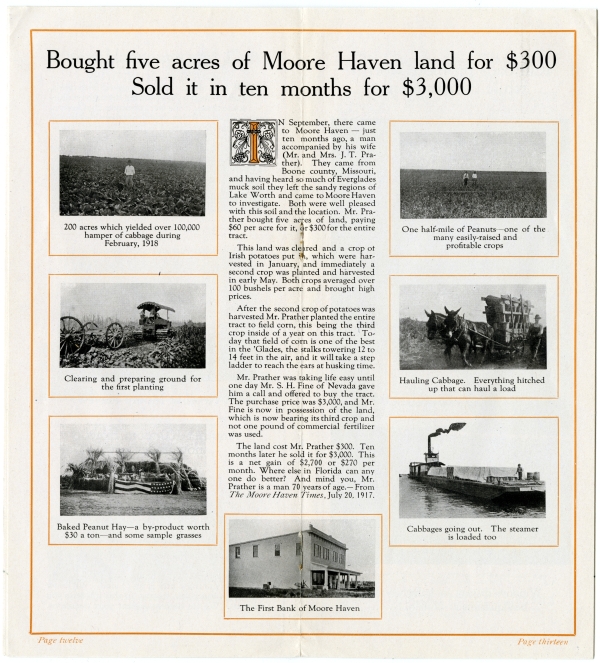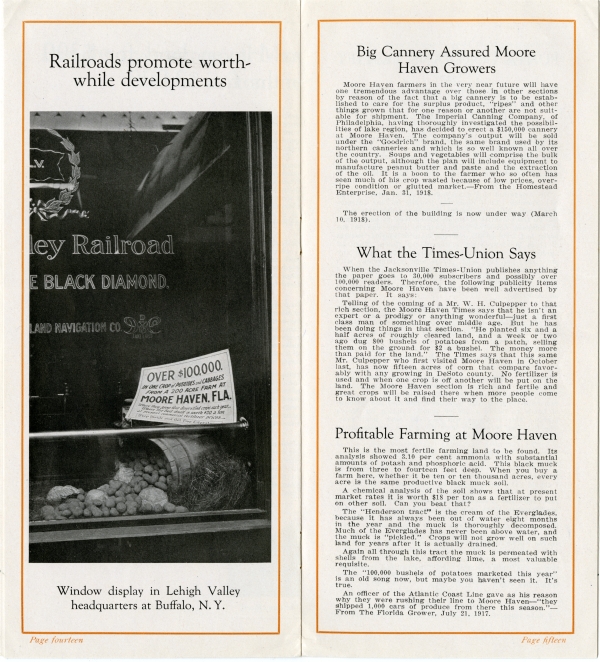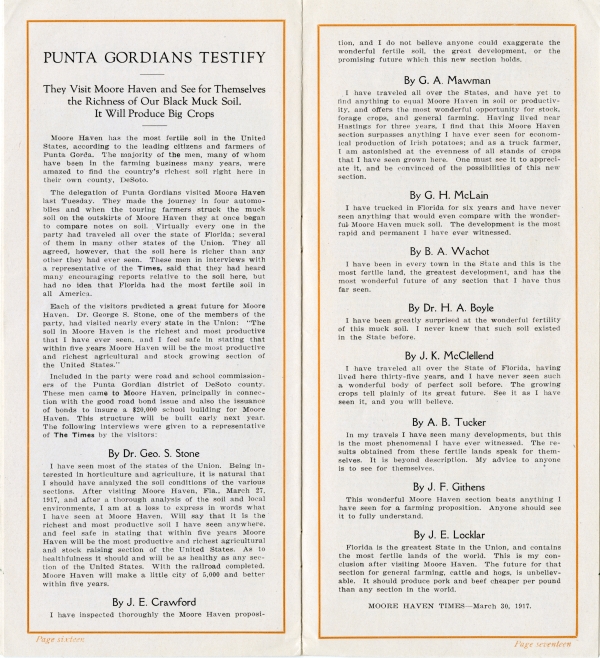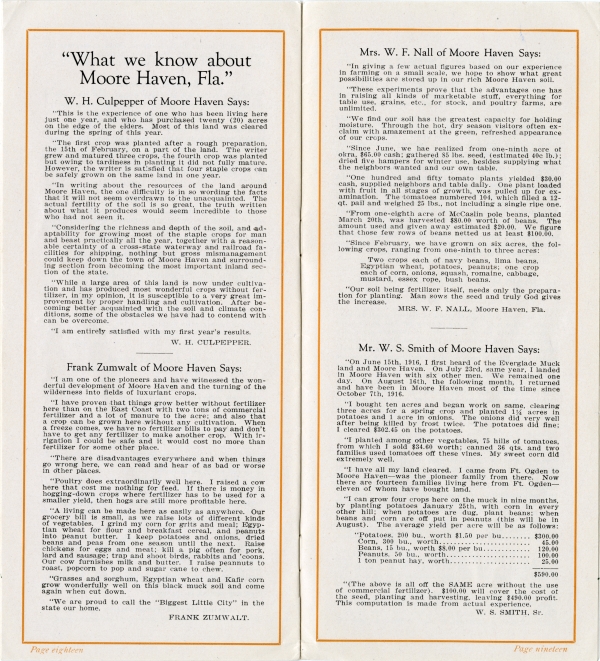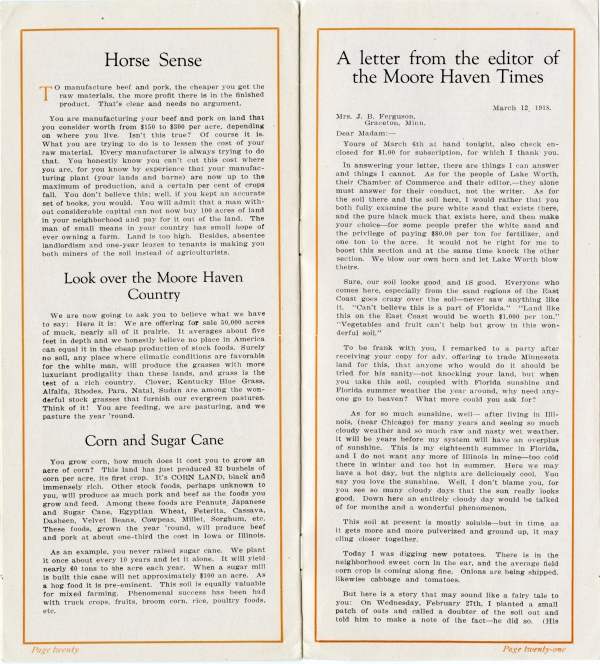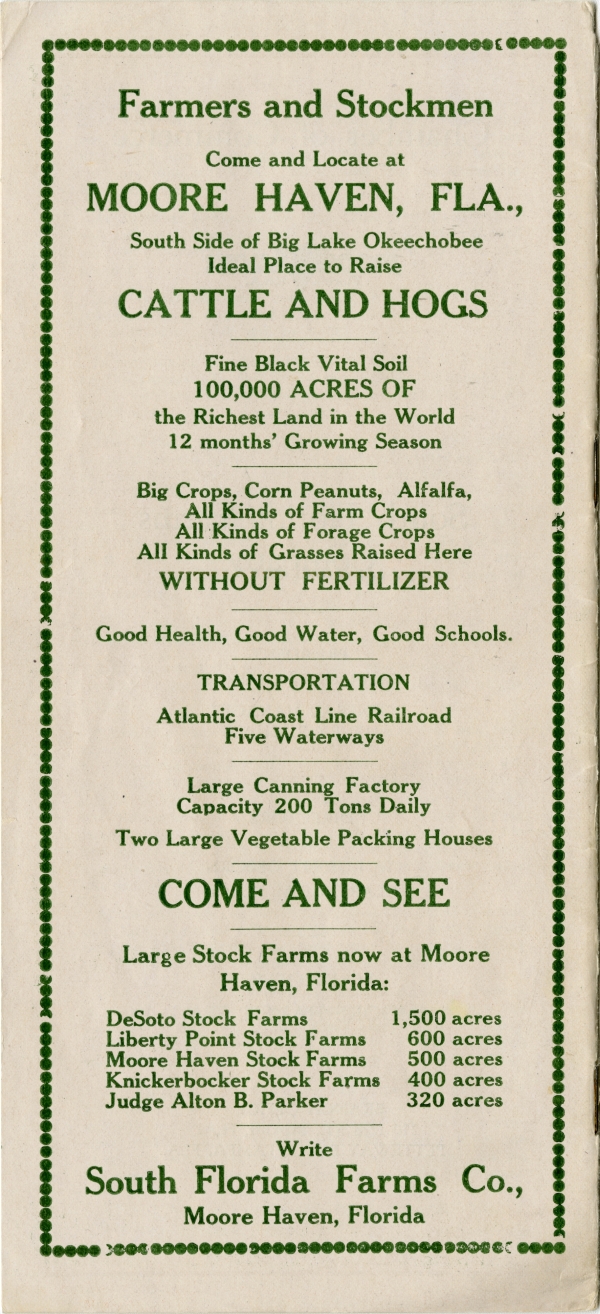Florida Memory is administered by the Florida Department of State, Division of Library and Information Services, Bureau of Archives and Records Management. The digitized records on Florida Memory come from the collections of the State Archives of Florida and the special collections of the State Library of Florida.

State Archives of Florida
- ArchivesFlorida.com
- State Archives Online Catalog
- ArchivesFlorida.com
- ArchivesFlorida.com
State Library of Florida
Related Sites
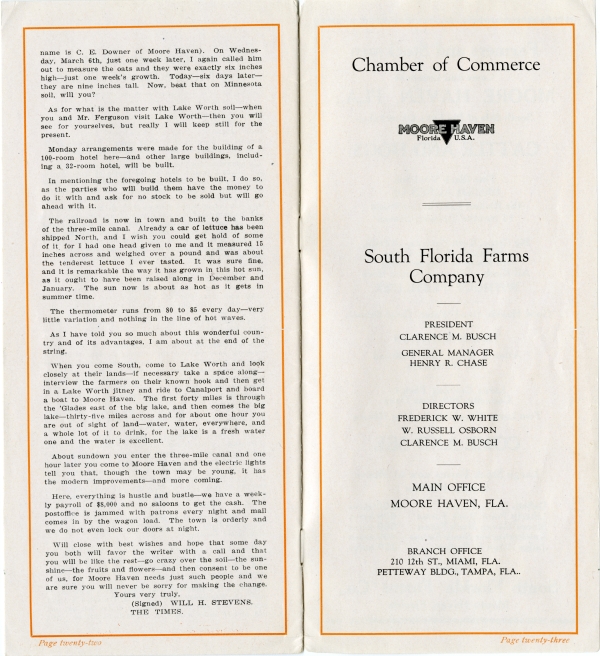
Description of previous item
Description of next item

South Florida Farms Company pamphlet promoting Moore Haven, Florida, ca. 1918
Source
Description
Date
Creator
Format
Geographic Term
As for what is the matter with Lake Worth soil--when you and Mr. Ferguson visit Lake Worth--then you will see for yourselves, but really I will keep still for the present.
Monday arrangements were made for the building of a 100-room hotel here--and other large buildings, including a 32-room hotel, will be built.
In mentioning the foregoing hotels to be built, I do so, as the parties who will build them have the money to do it with and ask for no stock to be sold but will go ahead and do it.
The railroad is now in town and build to the banks of the three-mile canal. Already a car of lettuce has been shipped North, and I wish you could get hold of some of it for I had one head given to me and it measured 15 inches across and weighed over a pound and was about the tenderest lettuce I ever tasted. It was sure fine, and it is remarkable the way it has grown in this hot sun, as it ought to have been raise along in December and January. The sun now is about as hot as it gets in summer time.
The thermometer runs from 80 to 85 every day--very little variation and nothing in the line of hot waves.
As I have told you so much about this wonderful country and of its advantages, I am about at the end of the string.
When you come South, come to Lake Worth and look closely at their lands--if necessary take a space along--interview the farmers on their known hook and then get in a Lake Worth jitney and ride to Canalport and board a boat to Moore Haven. The first forty miles is through the 'Glades east of the big lake, and then comes the big lake--thirty-five miles across and for about one hour you are out of sight of the land--water, water, everywhere, and a whole lot of it to drink, for the lake is a fresh water one and the water is excellent.
About sundown you enter the three-mile canal and one hour later you come to Moore Haven and the electric lights tell you that, though the town may be young, it has the modern improvements--and more coming.
Here everything is hustle and bustle--we have a weekly payroll of $8,000 and no saloons to get the cash. The post office is jammed with patrons every night and mail comes in by the wagon load. The town is orderly and we do not even lock our doors at night.
Will close with best wishes and hope that some day you both will favor the writer with a call and that you will be like the rest--go crazy over the soil--the sunshine--the fruits and flowers--and then consent to be one of us, for Moore Haven needs just such people and we are sure you will never be sorry for making the change.
Yours very truly,
(Signed) WILL H. STEVENS.
THE TIMES.
Page twenty-two
Chamber of Commerce
MOORE HAVEN
Florida, U.S.A.
South Florida Farms Company
PRESIDENT
CLARENCE M. BUSCH
GENERAL MANAGER
HENRY R. CHASE
DIRECTORS
FREDERICK W. WHITE
W. RUSSELL OSBORN
CLARENCE M. BUSCH
MAIN OFFICE
MOORE HAVEN, FLA.
BRANCH OFFICE
210 12th ST., MIAMI, FLA.
PETTEWAY BLDG., TAMPA, FLA.
Page twenty-three
Title
Subject
Description
Creator
Source
Date
Format
Language
Type
Identifier
Coverage
Geographic Term
Thumbnail
Display Date
ImageID
topic
Subject - Corporate
Transcript
From the land of year-long Spring
Fruits, Vegetables and Flowers every day in the year at
MOORE HAVEN, FLA.,
Large and Small Farms
COME AND SEE
MOORE HAVEN
Florida, U.S.A.
South Florida Farms Co.,
EVERYBODY knows that Florida has the most wonderful climate in the world. But much of the soil is poor and requires fertilization to the extent of from $80 to $100 per acre every year.
In a speech, Ex-Secretary of Agriculture Wilson has referred tot his district as--"rich alluvial lands, located in a climate that is almost absolute perfection, where there are no long, cold winters, no excessive heat in summer, no malaria or other diseases. Here, a thrifty careful tiller-of-the-soil can make more clear money, on ten or twenty acres, than on a farm of 150 acres in the North or West."
So says ex-cabinet member Wilson--nothing we could say would make that fact any stronger.
We have from three to four crops each year. We are near good markets. Our shipping facilities are good.
We do not use our time and energy to put away provisions for ourselves and our farm animals, to last through the winter. We do not split wood or shovel snow. We find growing good big crops more profitable.
It is hard for any farmer to realize that, here at Moore Haven, within your reach, is a farm every acre of which is covered with top soil, from two to ten feet thick, of wonderful fertilizing value. But that is true, and for a comparatively small sum, you can come to Moore Haven and see for yourself.
Come and talk with the farmers who have worked farms here. You will want to enjoy the same prosperity they now enjoy.
The time to act is now--before the land values have risen to their true level, for Moore Haven is not yet two years old. It's fame has spread, and farmers all over the country are coming in to enjoy the rich rewards that their labor deserves.
Won't you come down to Moore Haven and see our achievements? If you come, you will have no regret except that you did not come sooner.
Moore Haven Chamber of Commerce
Moore Haven, Florida
Page three
[photo caption] Pigs--A profitable by-product easily raised and marketed
[photo caption] Onions--ready for the markets of the north--way ahead of northern onions
[photo caption]A farm yard--great barns are not needed--fresh fodder the year 'round
Page four
Location
THIS tract of land is on the southwest shore of Lake Okeechobee, Florida, with 24 miles of lake frontage. This body of water is the largest fresh water lake in the United States that lies wholly within one state.
The commercial center of this tract is the new city of Moore Haven, located on the shore of the lake and Three Mile Canal (the only inland waterway in South Florida from east to west).
Some Facts
Any good farmer can conduct his business here to the best advantage.
Our own experience agrees with the testimony of such men as Ex-Secretary of Agriculture Wilson, Prof. Rose and Prof. Wiley of the State Agricultural forces, to wit--that soil here produces wonderful crops.
Moore Haven is strictly an ordinary, farmer's proposition--one that he thoroughly understands and can himself gauge accurately.
A small farm here, with every inch of its soil worth $20.00 a ton as fertilizer, can produce much more in crops with less labor, than farms several times larger elsewhere.
In Moore Haven, it is not necessary to build expensive home and farm buildings. This climate is always temperate.
Here, you need waste no time to put by, for a long cold winter. There are about 365 growing days, with from three to four crops per year from the same soil.
Moore Haven is a healthful, prosperous, rapidly growing community, with good shipping facilities.
Here a farm with from two to ten feet of this wonderful muck soil is within the reach of almost any farmer at a cost far less than the value of the first crops in many cases.
Moore Haven farms produce bigger returns than almost any other legitimate investment.
Page five
[photo caption] Egyptian Wheat--Notice (at right) the luxuriance of this precious crop.
[photo caption] Sugar cane--easily grown at Moore Haven--a money-making crop.
[photo caption] Peanuts--One of the many easily-raised, easily-sold crops
Page six
The State of Florida
DEPARTMENT OF AGRICULTURE
TALLAHASSEE
William A. McRae, commissioner
September 27, 1915.
MR. J. A. MOORE, Miami, Florida
My Dear Sir:
Replying to your favor of recent date in which you request me to give an opinion as to the character of the land near Lake Okeechobee, a part of which land being a portion of the tract known as "Henderson Tract" and recently taken over by your Company.
I am assuming that you desire an opinion on the entire tract, or what is known as the "Upper Glades" and as suggested by your inquiry to cover both the character of the land and its adaptability to the growing of staple crops such as sugar cane, and various grasses.
The term "Upper Glades" applies to the land lying adjacent to the Southern and Western boundaries of Lake Okeechobee and now represents the area of well drained land in the great Everglades.
The soil in that section ranges in depth from 3 to 12 feet and appears to be an older soil and more compact than the Everglade soil as a whole. This may be easily seen by the natural growth of that section near the Lake, which in addition to the saw grass, which covers the entire Everglades, are large areas covered with a growth of custard apple, willow and elderberry trees, and in many instances festooned with morning glory and other vines which gives it the appearance of real fairy land.
This great section will produce nearly everything known to us such as forage, cane, corn and practically everything in the vegetable line, and they are grown in and almost fabulous way.
I look upon this wonderful section as being that part of the United States which will produce sugar cane, corn, cattle and hogs at less cost per pound than any other like acreage known to us.
The natural grasses, as well as some of the more popular grasses, like para, rhodes and sudan, will carry three to four head of grown cattle per acre the year round.
As to the value of the land will state that the Trustees of the State lands have sold some in that locality for $100.00 per acre and the Board controlling these lands have recently turned down an offer of $115.00 per acre for a section lying on the Southwestern shore of Lake Okeechobee.
The tract which your Company owns was selected in 1885 and the party who purchased it had the entire Everglades to select from. The selection was made both for the quality of the soil and also because of the ease with which it could be drained.
I am glad to give you the above information and shall be pleased to service you further at any time you may need the services of this department.
Yours very truly,
(Signed) W. A. McRAE,
Commissioner of Agriculture
Page nine
[photo caption] A typical home of contented Moore Haven farmers
[photo caption] A substantial building which shows the progressiveness of Moore Haven
[photo caption] A cottage where a farmer can live comfortably and contentedly
Page ten
A Safe Investment
DON'T be afraid to invest in good farm lands, even though we are plowing through troublesome times. If the war continues, the Government will see to it that the farmer reaps his harvest. In the last year such men as Judge Alton B. Parker, Presidential Candidate in 1904, Governor of Florida Sidney J. Catts and Hon. William Jennings Bryan have invested here and are more than satisfied with their bargains. We can sell you ten or ten thousand acres of the richest agricultural land in the United States--on your terms if you are a farmer and will develop your purchase at once.
A Hotel at Moore Haven
Another 100-room Hotel is now under way
Our Proposition
The railroads run homeseekers' excursions to Florida points frequently at reduced rates. If you will come and see the Okeechobee country, we will allow you Fifty Dollars for a ticket, provided you purchase fifty acres of land. We know this will mean a sale to you. If this interests you write us. We are here to answer your questions.
Page eleven
Sold it in ten months for $3,000
[photo caption] 200 acres which yielded over 100,000 hamper of cabbage during February, 1918
[photo caption] Clearing and preparing ground for the first planting
[photo caption] Baked Peanut Hay--a by-product worth $30 a ton--and some sample grasses
Page twelve
IN September, there came to Moore Haven--just ten months ago, a man accompanied by his wife (Mr. and Mrs. J. T. Prather). They came from Boone county, Missouri, and having heard so much of Everglades muck soil they left the sandy regions of Lake Worth and came to Moore Haven to investigate. Both were well pleased with this soil and the location. Mr. Prather bought five acres of land, paying $60 per acre for it, or $300 for the entire tract.
This land was cleared and a crop of Irish potatoes put in, which were harvested in January, and immediately a second crop was planted and harvested in early May. Both crops averaged over 100 bushels per acre and brought high prices.
After the second crop of potatoes was harvested Mr. Prather planted the entire tract to field corn, this being the third crop inside of a year on this tract. Today that field of corn is one of the best in the 'Glades, the stalks towering 12 to 14 feet in the air, and it will take a step ladder to reach the ears at husking time.
Mr. Prather was taking life easy until one day Mr. S. H. Fine of Nevada gave him a call and offered to buy the tract. The purchase price was $3,000, and Mr. Fine is now in possession of the land, which is now bearing its third crop and not one pound of commercial fertilizer was used.
The land cost Mr. Prather $300. Ten months later he sold it for $3,000. This is a net gain of $2,7000 or $270 per month. Where else in Florida can any one do better? And mind you, Mr. Prather is a man 70 years of age.--From The Moore Haven Times, July 20, 1917.
[photo caption] The First Bank of Moore Haven
[photo caption] One half-mile of Peanuts--one of the many easily-raised and profitable crops.
[photo caption] Hauling Cabbage. Everything hitched up that can haul a load.
[photo caption] Cabbages going out. The steamer is loaded too.
Page thirteen
[photo caption] Window display in Lehigh Valley headquarters at Buffalo, N.Y.
Page fourteen
Big Cannery Assured Moore Haven Growers
Moore Haven farmers in the very near future will have one tremendous advantage over those in other sections by reason of the fact that a big cannery is to be established to care for the surplus product, "ripes" and other things grown that for one reason or another are not suitable for shipment. The Imperial Canning Company of Philadelphia, having thoroughly investigated the possibilities of lake region, has decided to erect a $150,000 cannery under the "Goodrich" brand, the same brand used by its northern canneries and which is so well known all over the country. Soups and vegetables will comprise the bulk of the output, although the plan will include equipment to manufacture peanut butter and paste and the extraction of the oil. It is a boon to the farmer who so often has seen much of his crop wasted because of low prices, overripe condition or glutted market.--From the Homestead Enterprise, Jan. 21. 1918.
The erection of the building is now under way (March 10, 1918).
What the Times-Union Days
When the Jacksonville Times-Union publishes anything the paper goes to 30,000 subscribers and possibly over 100,000 readers. Therefore, the following publicity items concerning Moore Haven have been well advertised by that paper. It says:
Telling of the coming of a Mr. W. H. Culpepper to that rich section, the Moore Haven Times says that he isn't an expert or a prodigy or anything wonderful--just a first class man of something over middle age. But he has been doing things in that section. "He planted six and a half acres of roughly cleared land, and a week or two ago dug 800 bushels of potatoes from a patch, selling them on the ground for $2 a bushel. The money more than paid for the land." The Times says that this same Mr. Culpepper who first visited Moore Haven in October last, has now fifteen acres of corn that compare favorably with any growing in DeSoto county. No fertilizer is used and when one crop is off another will be put on the land. The Moore Haven section is rich and fertile and great crops will be raised there when more people come to know about it and find their way to the place.
Profitable Farming at Moore Haven
This is the most fertile farming land to be found. Its analysis showed 3.10 per cent ammonia with substantial amounts of potash and phosphoric acid. This black muck is from three to fourteen feet deep. When you buy a farm here, whether it be ten or ten thousand acres, every acre is the same productive black muck soil.
A chemical analysis of the soil shows that at present market rates it is worth $18 per ton as a fertilizer to put on other soil. Can you beat that?
The "Henderson tract" is the cream of the Everglades, because it has always been out of water eight months in the year and the muck is thoroughly decomposed. Much of the Everglades has never been above water, and the muck is "pickled". Crops will not grow well on such land for years after it is actually drained.
Again all through this tract the muck is permeated with shells from the lake, affording lime, a most valuable requisite.
The "100,000 bushels of potatoes marketed this year" is an old song now, but maybe you haven't seen it. It's true.
An officer of the Atlantic Coast Line gave as his reason why they were rushing their line to Moore Haven--"They shipped 1,000 cars of produce from there this season."--From The Florida Grower, July 21, 1917.
Page fifteen
They Visit Moore Haven and See for Themselves the Richness of Our Black Muck Soil. It Will Produce Big Crops.
Moore Haven has the most fertile soil in the United States, according to the leading citizens and farmers of Punta Gorda. The majority of the men, many of whom have been in the farming business many years, were amazed to find the country's richest soil right here in their own county, DeSoto.
The delegation of Punta Gordians visited Moore Haven last Tuesday. They made the journey in four automobiles and when the touring farmers struck the muck soil on the outskirts of Moore Haven they at once began to compare notes on soil. Virtually every one in the part had traveled all over the state of Florida; several of them in many other states of the Union. They all agreed, however, that the soil here is richer than any other they had ever seen. These men in interviews with a representative of the Times, said that they had heard many encouraging reports relative to the soil here, but had no idea that Florida had the most fertile soil in all America.
Each of the visitors predicted a great future for Moore Haven. Dr. George S. Stone, one of the members of the party, had visited nearly every state in the Union: "The soil in Moore Haven is the richest and most productive that I have ever seen, and I feel safe in stating that within five years Moore Haven will be the most productive and richest agricultural and stock growing section of the United States."
Included in the party were road and school commissioners of the Punta Gordian district of DeSoto county. These men came to Moore Haven, principally in connection with the good road bond issue and also the insurance of bonds to insure a $20,000 school building for Moore Haven. This structure will be built early next year. The following interviews were given to a representative of The Times by the visitors:
By Dr. Geo. S. Stone
I have seen most of the states of the Union. Being interested in horticulture and agriculture, it is natural that I should have analyzed the soil conditions of the various sections. After visiting Moore Haven, Fla., March 27, 1917, and after a thorough analysis of the soil and local environments, I am at a loss to express in words what I have seen at Moore Haven. Will say that it is the richest and most productive soil I have seen anywhere, and feel safe in stating that within five years Moore Haven will be the most productive and richest agricultural and stock raising section of the United States. As to healthfulness it should and will be as healthy as any section of the United States. With the railroad completed, Moore Haven will make a little city of 5,000 and better within five years.
By J. E. Crawford
I have inspected thoroughly the Moore Haven proposi-
Page sixteen
tion, and I do not believe anyone could exaggerate the wonderful fertile soil, the great development, or the promising future which this new section holds.
By G. A. Mawman
I have traveled all over the States, and have yet to find anything to equal Moore Haven in soil or productivity, and offers the most wonderful opportunity for stock, forage crops, and general farming. Having lived near Hastings for three years, I find that this Moore Haven section surpasses anything I have ever seen for economical production of Irish potatoes; and as a truck farmer, I am astonished at the evenness of all stands of crops that I have seen grown here. One must see it to appreciate it, and be convinced of the possibilities of this new section.
By G. H. McLain
I have trucked in Florida for six years and have never seen anything that would even compare with the wonderful Moore Haven muck soil. The development is the most rapid and permanent I have ever witnessed.
By B. A. Wachot
I have been in every town in the State and this is the most fertile land, the greatest development, and has the most wonderful future of any section that I have thus far seen.
By Dr. H. A. Boyle
I have been greatly surprised at the wonderful fertility of this muck soil. I never knew that suck soil existed in the State before.
By J. K. McClellend
I have traveled all over the State of Florida, having lived here thirty-five years, and I have never seen such a wonderful body of perfect soil before. The growing crops tell plainly of its great future. See it as I have seen it, and you will believe.
By A. B. Tucker
In my travels I have seen many developments, but this is the most phenomenal I have ever witnessed. The results obtained from these fertile lands speak for themselves. It is beyond description. My advice to anyone is to see for themselves.
By J. F. Githens
This wonderful Moore Haven section beats anything I have seen for a farming proposition. Anyone should see it to fully understand.
By J. E. Locklar
Florida is the greatest State in the Union, and contains the most fertile lands of the world. This is my conclusion after visiting Moore Haven. The future for that section for general farming, cattle and hogs, is unbelievable. It should produce pork and beef cheaper per pound than any section in the world.
MOORE HAVEN TIMES--March 30, 1917.
Page seventeen
W. H. Culpepper of Moore Haven Says:
"This is the experience of one who has been living here just one year, and who has purchased twenty (20) acres on the edge of the elders. Most of this land was cleared during the spring of this year.
"The first crop was planted after a rough preparation the 15th of February, on a part of the land. The writer grew and matured three crops, the fourth crop was planted but owing to tardiness in planting it did not fully mature. However, the writer is satisfied that four staple crops can be safely grown on the same land in one year.
"In writing about the resources of the land around Moore Haven, the one difficulty is in so wording the facts that it will not seem overdrawn to the unacquainted. The actual fertility of the soil is so great, the truth written about what it produces would seem incredible to those who had not seen it.
"Considering the richness and depth of the soil, and adaptability for growing most of the staple crops for man and beast practically all the year, together with a reasonable certainty of a cross-state waterway and railroad facilities for shipping, nothing but gross mismanagement could keep down the town of Moore Haven and surrounding section from becoming the most important inland section of the state.
"While a large area of this land is now under cultivation and has produced most wonderful crops without fertilizer, in my opinion, it is susceptible to a very great improvement by proper handling and cultivation. After becoming better acquainted with the soil and climate conditions, some of the obstacles we have has to contend with can be overcome.
"I am entirely satisfied with my first year's results.
W. H. CULPEPPER.
Frank Zumwalt of Moore Haven Says:
"I am one of the pioneers and have witnessed the wonderful development of Moore Haven and the turning of the wilderness into fields of luxuriant crops.
"I have proven that things grow better without fertilizer here than on the East Coast with two tons of commercial fertilizer and a lot of manure to the acre; and also that a crop can be grown here without any cultivation. When a freeze comes, we have no fertilizer bills to pay and don't have to get any fertilizer to make another crop. With irrigation I could be safe and it would cost no more than fertilizer for some other place.
"There are disadvantages everywhere and when things go wrong here, we can read and hear of as bad or worse in other places.
"Poultry does extraordinarily well here. I raised a cow here that cost me nothing for feed. If there is money in hogging-down crops where fertilizer has to be used for smaller yield, then hogs are still more profitable here.
"A living can be made here as easily as anywhere. Our grocery bill is small, as we raise lots of different kinds of vegetables. I grind my corn for grits and meal; Egyptian wheat for flour and breakfast cereal, and peanuts into peanut butter. I keep potatoes and onions, dried beans and peas from one season until the next. Raise chickens for eggs and meat; kill a pig often for pork, lard and sausage; trap and shoot birds, rabbits and 'coons. Our cow furnishes milk and butter. I raise peanuts to roast, popcorn to pop and sugar cane to chew.
"Grasses and sorghum, Egyptian wheat and Kafir corn grow wonderfully well on this black muck soil and come again when cut down.
"We are proud to call the "Biggest Little City" in the state our home.
FRANK ZUMWALT.
Page eighteen
Mrs. W. F. Nall of Moore Haven Says:
"In giving a few actual figures based on our experience in farming on a small scale, we hope to show what great possibilities are stored up in our rich Moore Haven soil.
"These experiments prove that the advantages one has in raising all kinds of marketable stuff, everything for table use, grains, etc., for stock, and poultry farms, are unlimited.
"We find out soil has the greatest capacity for holding moisture. Through the hot, dry season visitors often exclaim with amazement at the green, refreshed appearance of our crops.
"Since June, we have realized from one-ninth acre of okra, $65.00 cash; gathered 85 lbs. seed, (estimated 40c lb.); dried five hampers for winter use, besides supplying what the neighbors wanted and our own table.
"One hundred and fifty tomato plants yielded $30.00 cash, supplied neighbors and table daily. One plant loaded with fruit in all stages of growth, was pulled up for examination. The tomatoes numbered 104, which filled a 12-qt. pail and weighed 25 lbs., not including a single ripe one.
"From one-eighth acre of McCaslin pole beans, planted March 20th, was harvested $80.00 worth of beans. The amount used and given away estimated $20.00. We figure that those few rows of beans netted us at least $100.00.
"Since February, we have grown on six acres, the following crops, ranging from one-ninth to three acres:
Two crops each of navy beans, lima beans, Egyptian wheat, potatoes, peanuts; one crop each of corn, onions, squash, romain, cabbage, mustard, essex rope, bush beans.
"Our soil being fertilizer itself, needs only the preparation for planting. Man sows the seed and truly God gives the increase.
MRS. W. F. NALL, Moore Haven, Fla.
Mr. W. S. Smith of Moore Haven Says:
"On June 15th, 1916, I first heard of the Everglade Muck land and Moore Haven. On July 23rd, same year, I landed in Moore Haven with six other men. We remained one day. On August 16th, the following month, I returned and have been in Moore Haven more of the time since October 7th, 1916.
"I bought ten acres and began work on same, clearing three acres for a spring crop and planted 1 1/4 acres in potatoes and 1 acre in onions. The onions did very well after being killed by frost twice. The potatoes did fine; I cleared $302.45 on the potatoes.
"I planted among other vegetables, 75 hills of tomatoes, from which I sold $34.60 worth; canned 36 qts. and two families used tomatoes off these vines. My sweet corn did extremely well.
"I have all my land cleared. I came from Ft. Ogden to Moore Haven--was the pioneer family from there. Now there are fourteen families living here from Ft. Ogden--eleven of whom have bought land.
"I can grow four crops here on the muck in nine months, by planting potatoes January 25th, with corn in every other hill; when potatoes are dug, plant beans; when beans and corn are off put in peanuts (this will be in August). The average yield per acre will be as follows:
"Potatoes, 200 bu., worth $1.50 per bu....$300.00
Corn, 300 bu., worth...45.00
Beans, 15 bu., worth $8.00 per bu....120.00
Peanuts, 50 bu., worth...100.00
1 ton peanut hay, worth...25.00
Total: $590.00
"(The above is all of the SAME acre without the use of commercial fertilizer). $100.00 will cover the cost of the seed, planting and harvesting, leaving $490.00 profit. This computation is made from actual experience.
W. S. SMITH, Sr.
Page nineteen
TO manufacture beef and pork, the cheaper you get the raw materials, the more profit there is in the finished product. That's clear and needs no argument.
You are manufacturing your beef and pork on land that you consider worth from $150 to $300 per acre, depending on where you live. Isn't this true? Of course it is. What you are trying to do is to lessen the cost of your raw material. Every manufacturer is always trying to do that. You honestly know you can't cut this cost where you are, for you know by experience that your manufacturing plant (your lands and your barns) are now up to the maximum of production, and a certain per cent of crops fail. You don't believe this; well, if you keep an accurate set of books, you would. You will admit that a man without considerable capital can now buy 100 acres of land in your neighborhood and pay for it out of the land. The man of small means in your country has small hope of ever owning a farm. Land is too high. Besides, absentee landlordism and one-year leases to tenants is making you both miners of the soil instead of agriculturalists.
Look over the Moore Haven County
We are now going to ask you to believe what we have to say: Here it is: We are offering for sale 50,000 acres of muck, nearly all of it prairie. It averages about five feet in depth and we honestly believe no place in America can equal it in the cheap production of stock foods. Surely no soil, any place where climatic conditions are favorable for the white man, will produce the grasses with more luxuriant prodigality than these lands, and grass is the test of a rich country. Clover, Kentucky Blue Grass, Alfalfa, Rhodes, Para, Natal, Sudan are among the wonderful stock grasses that furnish our evergreen pastures. Think of it! You are feeding, we are pasturing, and we pasture the year 'round.
Corn and Sugar Cane
You grow corn, how much does it cost you to grow an acre of corn? This land has just produced 82 bushels of corn per acre, its first crop. It's CORN LAND, black and immensely rich. Other stock foods, perhaps unknown to you, will produce as much pork and beef as the foods you grow and feed. Among these foods are Peanuts, Japanese and Sugar Cane, Egyptian Wheat, Feterita, Cassava, Dasheen, Velvet Beans, Cowpeas, Millet, Sorghum, etc. These foods, grown the year 'round, will produce beef and pork at about one-third the cost in Iowa or Illinois.
As an example, you never raised sugar cane. We plant it once about every 10 years and let it alone. It will yield nearly 60 tons to the acre each year. When a sugar mill is built this cane will net approximately $100 an acre. As a hot food it is pre-eminent. This soil is equally valuable for mixed farming. Phenomenal success has been had with truck crops, fruits, broom corn, rice, poultry foods, etc.
Page twenty
A letter from the editor of the Moore Haven Times
March 12, 1918.
Mrs. J. B. Ferguson,
Graceton, Minn.
Dear Madam:--
Yours of March 6th at hand tonight, also check enclosed for $1.00 for subscription, for which I thank you.
In answering your letter, there are things I can answer and things I cannot. As for the people of Lake Worth, their Chamber of Commerce and their editor,--they alone must answer for their conduct, not the writer. As for the soil there and the soil here, I would rather that you both fully examine the pure white sand that exists there, and the pure black muck that exists here, and then make your choice--for some people prefer the white sand and the privilege of paying $80.00 per ton for fertilizer, and one ton to the acre. It would not be right for me to boost this section and at the same time knock the other section. We blown our own horn and let Lake Worth blow theirs.
Sure, our soil looks good and IS good. Everyone who comes here, especially from the sand regions of the East Coast goes crazy over the soil--never saw anything like it. "Can't believe this is a part of Florida." "Land like this on the East Coast would be worth $1,000 per ton." "Vegetables and fruit can't help but grow in this wonderful soil."
To be frank with you, I remarked to a party after receiving your copy for adv. offering to trade Minnesota land for this, that anyone who would do it should be tried for his sanity--not knocking on your land, but when you take this soil, coupled with Florida sunshine and Florida summer weather the year around, why need anyone to go to heaven? What more could you ask for?
As for so much sunshine, well--after living in Illinois, (near Chicago) for many years and seeing so much cloudy weather and so much raw and nasty wet weather, it will be years before my system will have an overplus of sunshine. This is my eighteenth summer in Florida, and I do not want any more of Illinois in mine--too cold there in winter and too hot in summer. Here we may have a hot day, but the nights are deliciously cool. You say you love the sunshine. Well, I don't blame you, for you see so many cloudy days that the sun really looks good. Down here an entirely cloudy day would be talked of for months and a wonderful phenomenon.
This soil at present is mostly soluble--but in time as it gets more and more pulverized and ground up, it may cling close together.
Today I was digging new potatoes. There is in the neighborhood sweet corn in the ear, and the average field corn crop is coming along fine. Onions are being shipped likewise cabbage and tomatoes.
But here is a story that may sound like a fairy tale to you: On Wednesday, February 27th, I planted a small patch of oats and called a doubter of the soil out and told him to make a note of the fact--he did so. (His
Page twenty-one
As for what is the matter with Lake Worth soil--when you and Mr. Ferguson visit Lake Worth--then you will see for yourselves, but really I will keep still for the present.
Monday arrangements were made for the building of a 100-room hotel here--and other large buildings, including a 32-room hotel, will be built.
In mentioning the foregoing hotels to be built, I do so, as the parties who will build them have the money to do it with and ask for no stock to be sold but will go ahead and do it.
The railroad is now in town and build to the banks of the three-mile canal. Already a car of lettuce has been shipped North, and I wish you could get hold of some of it for I had one head given to me and it measured 15 inches across and weighed over a pound and was about the tenderest lettuce I ever tasted. It was sure fine, and it is remarkable the way it has grown in this hot sun, as it ought to have been raise along in December and January. The sun now is about as hot as it gets in summer time.
The thermometer runs from 80 to 85 every day--very little variation and nothing in the line of hot waves.
As I have told you so much about this wonderful country and of its advantages, I am about at the end of the string.
When you come South, come to Lake Worth and look closely at their lands--if necessary take a space along--interview the farmers on their known hook and then get in a Lake Worth jitney and ride to Canalport and board a boat to Moore Haven. The first forty miles is through the 'Glades east of the big lake, and then comes the big lake--thirty-five miles across and for about one hour you are out of sight of the land--water, water, everywhere, and a whole lot of it to drink, for the lake is a fresh water one and the water is excellent.
About sundown you enter the three-mile canal and one hour later you come to Moore Haven and the electric lights tell you that, though the town may be young, it has the modern improvements--and more coming.
Here everything is hustle and bustle--we have a weekly payroll of $8,000 and no saloons to get the cash. The post office is jammed with patrons every night and mail comes in by the wagon load. The town is orderly and we do not even lock our doors at night.
Will close with best wishes and hope that some day you both will favor the writer with a call and that you will be like the rest--go crazy over the soil--the sunshine--the fruits and flowers--and then consent to be one of us, for Moore Haven needs just such people and we are sure you will never be sorry for making the change.
Yours very truly,
(Signed) WILL H. STEVENS.
THE TIMES.
Page twenty-two
Chamber of Commerce
MOORE HAVEN
Florida, U.S.A.
South Florida Farms Company
PRESIDENT
CLARENCE M. BUSCH
GENERAL MANAGER
HENRY R. CHASE
DIRECTORS
FREDERICK W. WHITE
W. RUSSELL OSBORN
CLARENCE M. BUSCH
MAIN OFFICE
MOORE HAVEN, FLA.
BRANCH OFFICE
210 12th ST., MIAMI, FLA.
PETTEWAY BLDG., TAMPA, FLA.
Page twenty-three
Come and Locate at
MOORE HAVEN, FLA.,
South Side of Big Lake Okeechobee
Ideal Place to Raise
CATTLE AND HOGS
Fine Black Vital Soil
100,000 ACRES OF
the Richest Land in the World
12 months' Growing Season
Big Crops, Corn Peanuts, Alfalfa,
All Kinds of Farm Crops
All Kinds of Forage Crops
All Kinds of Grasses Raised Here
WITHOUT FERTILIZER
Good Health, Good Water, Good Schools.
TRANSPORTATION
Atlantic Coast Line Railroad
Five Waterways
Large Canning Factory
Capacity 200 Tons Daily
Two Large Vegetable Packing Houses
COME AND SEE
Large Stock Farms now at Moore Haven, Florida:
DeSoto Stock Farms 1,500 acres
Liberty Point Stock Farms 600 acres
Moore Haven Stock Farms 500 acres
Knickerbocker Stock Farms 400 acres
Judge Alton B. Parker 320 acres
Write
South Florida Farms Co.,
Moore Haven, Florida
Chicago Manual of Style
South Florida Farms Company. South Florida Farms Company pamphlet promoting Moore Haven, Florida, ca. 1918. 1918 (circa). State Archives of Florida, Florida Memory. <https://www.floridamemory.com/items/show/318847>, accessed 25 November 2025.
MLA
South Florida Farms Company. South Florida Farms Company pamphlet promoting Moore Haven, Florida, ca. 1918. 1918 (circa). State Archives of Florida, Florida Memory. Accessed 25 Nov. 2025.<https://www.floridamemory.com/items/show/318847>
AP Style Photo Citation
(State Archives of Florida/South Florida Farms Company)

 Listen: The Blues Program
Listen: The Blues Program